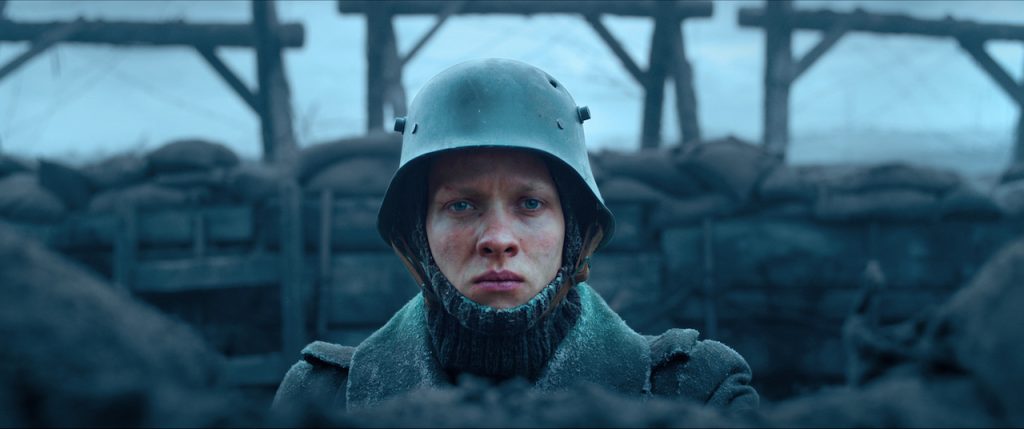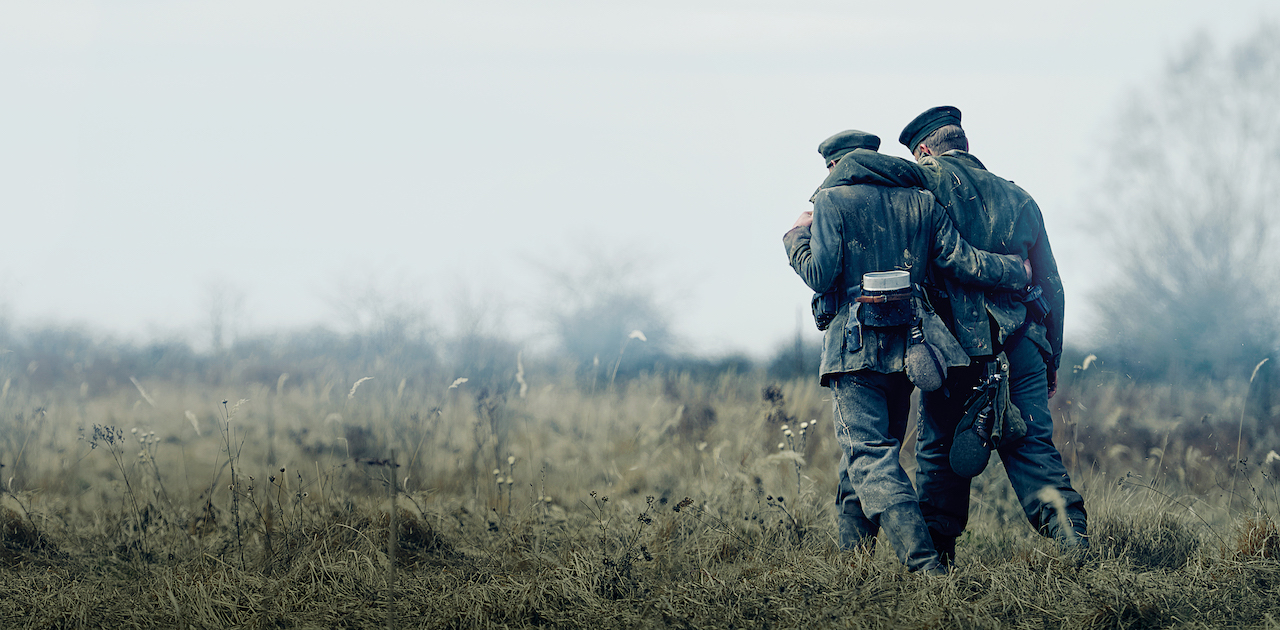“I was a rugby player and a ballet dancer,” says Lesley Paterson, triathlete and co-screenwriter of the Oscar nominated All Quiet on the Western Front. Dabbling in acting and producing, it wasn’t until she met her writing partner Ian Stokell that she felt like screenwriting could be a path to a career in filmmaking.
“To be able to act, you have to be able to write and produce your own films,” Stokell tells her. “Well that makes sense,” she agrees. “So that’s when I got into the writing side of things.” Having read the novel of All Quiet On The Western Front in high school, she was intrigued by the idea of adapting the iconic novel into a movie.
It’s remarkable to think of Paterson writing an Oscar-nominated screenplay and training as a triathlete, but it’s because she views both as one and the same discipline “I get up early. I’m an early person. Not everyone is, but we do know that there is neuroscience of the brain from training.”
Paterson, along with her husband Simon Marshall, PhD, have written extensively about these topics in their book, The Brave Athlete. “You have more motivation in the morning,” she asserts. “There’s a part of your brain that processes emotional and physical pain and that tires out later in the day.”
“For me, it’s about slicing things into small chunks to make them manageable. That’s in training. That’s in exercise as well as screenwriting or filmmaking, because if you look at the whole it’s so overwhelming that we never even bother starting.”
Paterson says, this way, whenever you conquer one of the smaller tasks, you get a little hit of dopamine in the brain which inspires you to continue. “We know that it creates motivation to do the next thing. Don’t think of the whole. Just think of the small bits.”
Paterson and Marshall use this same technique in their coaching business when they work with world class athletes. “It might even be just walking around the block, then the next day, you jog for 2 minutes, then 3 minutes. You just build those bricks like that.” The same is true for beats in a screenplay.
“When you’re in that writing space, have a schedule, have a system, have a routine. Your brain loves routine, so create that routine for success. Break your day up, have your coffee, but pair that with a habit. What are you going to achieve? Break it down and give yourself rewards along the way. Give yourself little hits of dopamine throughout the day.”
Writing All Quiet on the Western Front
At a bookshop in Los Angeles, the two screenwriters found copies of All Quiet on the Western Front on sale and realized no one had done an adaptation of the book since 1979, so perhaps it was a good time to bring it back to the big screen. This was back in 2006.
“We’re kind of Mavericks as you can tell from my sporting background and Ian’s a journalist. So we looked into who had the rights and nobody did, which was kind of shocking. So we embarked on getting the rights, getting a lawyer on board, and using our savings to pay for that.”

Lesley Paterson
Paterson jokes, “That was a feat in and of itself. No name writers trying to acquire the rights to a massive title. That was bizarre in itself. But then it was, what the hell do you do now?” Ultimately, the writers knew it was time to read the novel multiple times, rip it up and put it on the wall, and “get to the essence of what the author was trying to say.”
And, with any adaptation, what were the problems of trying to translate all of this cinematically? “With all of that information, we did a lot of research, read trench war diaries, and got into the history of World War 1, the context of it… because one of biggest issues with the novel is the fact that it’s excerpts of a diary, so it’s quite meandering and ethereal.”
The writers needed a “dramatic through line” to carry the story.
What they found was the
1. signing of the armistice,
2. reparations Germany had to pay, and
3. the last six hours of the war, which were a ticking clock.
This created dramatic tension and helped line up the themes from the book.
Put Yourself in Their Shoes
Not unlike Clint Eastwood’s Letters From Iwo Jima, a companion to Flags of Our Fathers, the story of All Quiet on the Western Front shows the German perspective of World War I, which is often overlooked in American filmmaking.
“Ultimately, in an adaptation, you take the essence of the material and look at it through the lens of which you live. It was written before World War II, so we have knowledge they don’t have. It’s something they learn. As an ally, we really don’t know the other side. You put yourself in the others’ shoes.”
Through multiple drafts and decades of work, the writers found something they believed in. “That took about two years. Then it was about packaging it and putting it together. We’re also producers because we went through many iterations of producers on, producers off, going to jail (not us going to jail — them going to jail), moneys on, moneys off, different cast, different crew… certainly when we embarked on this, we couldn’t have raised the finance for a German-speaking film. But things changed.”
Paterson gives credit to a handful of things happening that led to this German-speaking film.
1. Parasite won for Best Picture.
2. 1917 proved interest in World War I.
3. Streamers encouraged local language content.
She continues, “All of a sudden, that opportunity came along with Edward Berger, who wanted to make it in German.”
That said, there’s still a lot of teaching that essentially needs to be done in a film like this one. The audience isn’t coming in with as much knowledge about this war, unlike World War II or Vietnam, which have been covered over and over again in countless films.
Educating the Audience
Potential spoilers for the film ahead.
“Ultimately, it’s the world right? World War I is such a unique world. Trench warfare is alien. So we had to set the scene. This is what you’re in for as an audience member. The hardest part of that is the fact that we wanted to show Paul (Felix Kammerer) sign up. So how do we move from the battlefield to him? That’s when we came up with the uniform being the transition piece.”
In the film, the audience is invited to see somewhat of a mini-movie to set the stage. A soldier, scared for his life, has to charge forward as bullets and explosions happen all around him. He tries to save a friend, but instead watches the man perish. He fires shots, but eventually is also killed. His coat — and his story — eventually becomes Paul’s story. “We thought that was the message of the entire film: the uniform’s worth more than man.”
“An opening is so key, right? We wanted to start on the battlefield, but we needed to see Paul’s innocence. I was on a run one day and a lot of my ideas come when I’m exercising. I had just watched Schindler’s List and [I was thinking about] the sequence with the girl in the red coat. It just spawned this idea. Wouldn’t be cool if…? Then you just kind of build on it.”
Looking back, Paterson says she knew that “even if the rest of the film was total shite, this was an Oscar worthy opening.” She laughs, “We doubt ourselves so much, so when you have a good idea and you know it, you put that stake in the sand.”
Another educational point for this film came in the form of unknowns for the characters. Meaning, they had never really seen a tank before and they didn’t know what chemical warfare meant. So when we see a tank for the first time, or experience a rain-filled trench, or spot dozens of men killed for removing their masks too early, it’s all the more heartbreaking because they don’t know what they don’t know.

Paul Bäumer (Paul Bäumer) Photo courtesy of Netflix
“That comes down to casting, the director, the color palette — all of these things. With that innocence, we want to show these young lads are going to get shot and the only training they’ve had is on the truck, on the way to the front line. As an audience, you’ve seen the battlefield, so you view these young men with dread.”
Common Problems in Screenplays
As a producer, Paterson has read hundreds or thousands of scripts over the years. Some common problems she finds from novice writers occur when “staying too long in a scene.” She says, “Come in late, leave early. [Don’t] try to say too much. The quiet moments are good. Less is more. Give room to the viewer to live in the moment. Don’t push through as if you have to say and do everything.”
This also means leaving room for the Director and leaving room for the Actors to bring something to the table. “View every scene with a gravitas, so you have a sense of the scene but you’re not necessarily spelling everything out.” Within this open space, the writers did show potential team members photographs and trench diary letters.
“They always seemed to sort of encapsulate the emotion of what we were trying to get after. We had photographs and vision boards that we took to Directors and other Producers.” This look book somewhat helped them better sell their overall idea for what became the film. It also helped them stick it out while writing such bleak material.
“I’ve grown up with monuments of men that lost their lives and there’s a responsibility to tell that story, so we can raise a discourse and have an impact. I think that was the motivating factor that kept me going through the darkness. You feel like you just have to tell this story. I can’t imagine what the mothers, the daughters, the wives…your entire town was decimated and there were no men left. I think that’s enough motivation to push forward.”
And for a final bit of advice on persistence, Paterson tells writers, “Stay true to your why. Know why it’s important to you. Why are you doing this? Why are you telling this story? Why are you a screenwriter? I think if you focus on the mastery of the craft rather than the outcome — commitment to every small piece — then that’s a massive success. You piece all of those together like a little brick house and that’s what will bring you success in the end.”
This interview has been condensed. Listen to the full audio version here.

